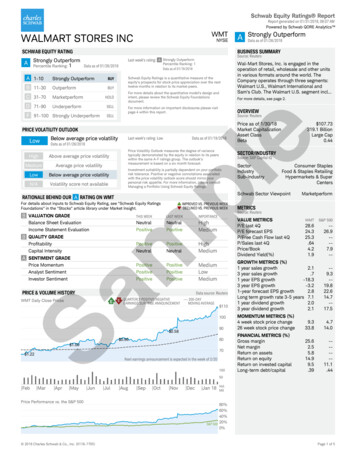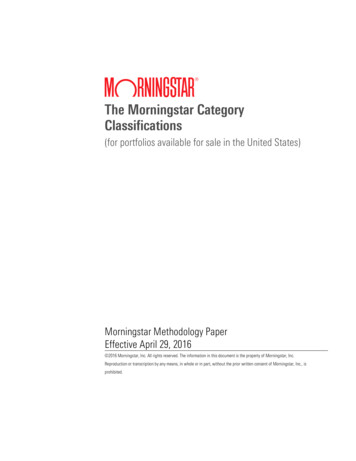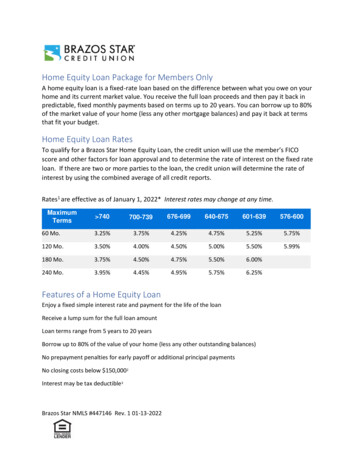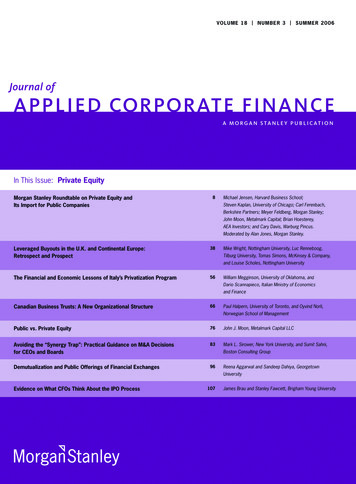
Transcription
EQUITY RESEARCH June 1, 2016EXCERPTED FROM THE ORIGINAL: See inside cover for detailsThe Asian ConsumerINDIA CONSUMER CLOSE-UPTapping the spending power of a young, connected Urban MassThe story of the rising Asian Consumer class is incomplete without a solidunderstanding of India. With a young, tech-savvy population, improved educationand rapid growth, India is creating a consumer market deeply tied into mobility andconnectivity. Where spending in neighbors like China is driven by an emerging UrbanMiddle class, we see the greatest opportunities in India in the much larger UrbanMass. In the latest report in our Asian Consumer series, we examine how India’sunique characteristics create opportunities that range from packaged snacks andrestaurants to baby products, smartphones and scooters.Joshua Lu 852-2978-1024joshua.lu@gs.comGoldman Sachs (Asia) L.L.C.Anita Yiu 852-2978-7200anita.yiu@gs.comGoldman Sachs (Asia) L.L.C.Aditya Soman 91(22)6616-9345aditya.soman@gs.comGoldman Sachs India SPLGoldman Sachs does and seeks to do business with companies covered in its research reports. As aresult, investors should be aware that the firm may have a conflict of interest that could affect theobjectivity of this report. Investors should consider this report as only a single factor in making theirinvestment decision. For Reg AC certification and other important disclosures, see the DisclosureAppendix, or go to www.gs.com/research/hedge.html. Analysts employed by non-US affiliates are notregistered/qualified as research analysts with FINRA in the U.S.The Goldman Sachs Group, Inc.
June 1, 2016India Consumer Close-upTable of contentsPM Summary3India: The Macro, The People, The Consumer6Indian Consumer – Identify the key cohorts7Why India will have a different path of growth compared to China12What consumers are buying: 7 consumption desires16Disclosure Appendix20The following is an excerpt from “India Consumer Close-up: Tapping the spending power of a young, connected UrbanMass”, published June 1, 2016, 87 pgs. All company references in this excerpt are for illustrative purposes only and shouldnot be interpreted as investment recommendations.We would like to thank the many colleagues from across the Goldman Sachs Global Investment Research team whocontributed to this report, especially Sef Chin and Aditya Gupta for their valuable contributions.Asia Consumer TeamIndiaJoshua LuSho KawanoAdam AlexanderMichelle ChengChristine ChoAndrea ChongLincoln KongXufa LiaoJingyuan LiuAditya SomanKeiko YamaguchiAnita YiuJune ZhuEnergyNikhil BhandariVinit man Sachs Global Investment pital goods, Infrastructure, UtilitiesPulkit Patnipulkit.patni@gs.comMaterialsNavin GuptaIndrajit tomobilesPramod KumarSumeet al ServicesRahul Jainrahul.m.jain@gs.comHealthcareShyam Srinivasanshyam.srinivasan@gs.comIT Services, InternetRishi Jhunjhunwalarishi.jhunjhunwala@gs.comConsumer, Telecom,Aditya SomanMacro ResearchVishal om2
June 1, 2016India Consumer Close-upPM SummaryIn this report, we turn the focus of our Asian Consumer series to the world’s secondbiggest population, India. With 440mn millennials and 390mn Gen Z teens and children,the sheer size of India’s youth paves the way for India’s consumer story to be one of theworld’s most compelling in the next 20 years. We examine how India’s consumerspending will shift as its consumer class grows, drawing on lessons from our work in Chinawith an eye towards the characteristics that make India unique.As with our China Consumer Close Up report last year, our starting point differs from theprevailing research by forming a holistic view of the consumer before examining aparticular consumer-related industry. We begin by dividing the working population intocohorts, an approach that has allowed us to form a more complete and accurate picture ofthe Chinese consumer. For India, a country with huge diversity, we believe moving past asimple national average is essential to identify the real opportunities and challenges withinthe consumer population.We believe India will develop differently from China, where the first wave of the consumerstory was powered by the 156mn Urban Middle workforce and 1.5mn wealthy “Movers &Shakers.” For India, we see the consumer growth story instead underpinned by the UrbanMass. India’s Urban Middle is much smaller at just 27mn working people, or 2% of thepopulation. We believe most of the new generation of India’s youth will first fall intoUrban Mass, a cohort that is 129mn people today, earning over US 3,200 on average. Theexpansion of Urban Mass, both in size and income level, will be the key driver of India’sconsumption story in the coming 5-10 years.Just as China has the phrase “衣 (clothing) 食 (food) 住 (shelter) 行 (mobility)“ to describelife’s essential needs, India has its equivalent in the form of “roti kapda aur makaan” –meaning “food, clothing, and shelter”. We focus on 7 key areas of consumption desire thatcapture c.96% of total consumption expenditure: 1) Eating better; 2) Looking better; 3)Better home; 4) Mobility and Connectivity; 5) Having more fun; 6) Well-being; 7) Luxury.We overlay on these desires a simple “hours worked” affordability test and anunderstanding of what is “Uniquely Indian” that influences behavior. These uniquecharacteristics are everywhere, with profound effects on consumer behavior: almost halfthe population is vegetarian, whisky sales dwarf beer, and families save for years to spendon their child’s wedding.Combining these factors helps create a framework to identify categories well positioned tobenefit from the rise of India’s consumer class. Particular opportunities range frompackaged snacks and dairy products to restaurants, premium personal care products, babyproducts, smartphones, scooters and branded jewelry. We believe mobile connectivityand ecommerce stand to leapfrog traditional retail as channels for reaching young andtech-savvy consumers.The result is a picture that is both uniquely Indian and emblematic of a growing pool ofconsumers across Asia that will shape spending in the decades to come.Goldman Sachs Global Investment Research3
June 1, 2016India Consumer Close-upIndia consumer – Top takeaways1)India’s consumer story willwill be shapedshaped byby itsits 440mn440mn MillennialsMillennials andand 390mn390mn2000).TheThe sheersheer sizesize ofof India’sIndia’s youthyouth combinedcombined withwithGen Z (born after 2000).improved education pave the way for sustained growth in purchasing powerpowerand makes India’s consumer story one of the world’s most compelling for thenext 20 years. The nation’s challenge is to create enough jobs to unleash theproductivity of India’s talented youth.2)India’s GDP perper capitacapita –– atat US 1,650US oChinaChinainin2005.2005.consumer storystory willwill bebe ledled bybyitsits130mn129mn UrbanUrbanIn the coming decade, India’s consumerMass consumers. This marks a different path from China, which waspredominantly an Urban Middle formation story during 2002-2012.3)India’sUrbanUrban MiddleMiddle cohortcohort isis relativelysmall. Wesmall.estimatethe workforcethatIndia’sWe thatestimatethat the workforcefallsinto theMiddle(US 11,000annual income)at 27mn,that fallsintoUrbanthe UrbanMiddle(over US 11,000annualstandsincome)stands orat 2%27mn, orofIt will expand, but investors need to be careful in calibrating the2%population.of population.potential addressable market for companies targeting this cohort.Brand investing will be a big theme in everything. But we note: India’sUrban Mass will trade up into brands that offer the most incremental valueBrandinvestingwillnotbereadilya big themein aspirationaleverything. brands.But be careful:weandquality,but mayjump toIn purchasingabelievethat India’sMassconsumer,will trade anup importantinto brandsthatisoffersthe mostcar for example,forUrbanan Indianinputthe brand’sincrementalvalue,may not readily jump to aspirational brands. Inreputation forfuel butefficiency.purchasing a car, for example, India consumer’s first criteria is the brand’sreputationfor fuel positionedefficiency. for profit pool expansion: packaged snacks,Best categoriesbaby products, premium personal care, scooters, SUVs and jewelry. But oneBest poolcategoriespositionedforprofitexpansion: packaged snacks,profitmay growfaster thanthemall: poolrestaurants.baby products, premium personal care, scooters, SUVs and jewelry. But oneprofitmayfasterthemall: ost:Mobileconnectivity and Ecommerce.Payment system and supply chain challenges remain but are notWhereIndia will leapfrogmost:connectivityMobile connectivityand Ecommerce.insurmountable.Improvedthemobilewill also rtainmentbut are not over time,dominationof TVandas asupplyprimarysourceof ilechallengethecreating a biggerImprovedprofit poolmobilefor contentprovidersgaming.domination of TV as a primary source of household entertainment over time,creatinga biggerpool forcontentprovidersmobilegaming. India’sGrowth ofluxuryprofitand highendin generalwill beandlimited.Culturally,affluent consumers tend to shy away from ostentatious display of wealth. OneGrowthof luxuryhigh endin generalThewillnumberbe limited.Culturally,andIndia’sarea whereIndiansanddo splurge:weddings.of weddingshouseholdformationswillthenext 5 aseshy awayoverfromostentatiousdisplaywealth. Onedemographics(peakdobirthnumbersreached 22-23ago).of weddings andareawhere Indianssplurgeon: weddings.Theyrsumberhousehold formations will increase over the next 5 years, given India’sdemographics (peak birth reached 22-23 yrs ago).4)5)6)7)Goldman Sachs Global Investment Research4
June 1, 2016India Consumer Close-upINDIA’S CONSUMERSin numbers(1 Country, 780 Languages)BIG POPULATION, FAST ECONOMYWORKING MASS and MIDDLE1.3bn / 7.5%10% / 2%India’s population and real GDP growth in 2015.The portion of the total population made up of theworkforce in “Urban Mass” / “Urban Middle.”YOUNG POPULATIONBIG FUTURES65%7mnThe percentage of the populationborn after 1980. Of the 65%, 443million are Millennials and 393 millionare Generation Z.WELL-CONNECTED6200mnThe number of connected smartphoneswe expect by end of 2016. Telecom ARPUis only US 3/month, among the lowest inthe world.The number of college graduatesper year.The number of Fortune Magazine’s“Most Admired” Americancompanies with Indian CEOs:Adobe, Berkshire HathawayReinsurance, Google, MasterCard,Microsoft and Pepsi.ON THE MENU40%The percentage of the totalpopulation that is vegetarian.60mnThe size of India’s milk market intons – the largest in the world.BOLLYWOOD DREAMS1,602The number of Bollywood filmsproduced in India, selling 1.9 billioncinema tickets. TV penetration is alsohigh (67%) relative to other homeappliances.PUTTING A RING ON ITUS 7,500 – 75,000 The cost of a wedding in India, vs. an average cost ofUS 30,000 in the US and urban China. The average2015 income of the Urban Mass was US 3,216.US 27bnAnnual gold demand. India is the second largest goldconsumer globally.Goldman Sachs Global Investment Research 31bnThe size of the spirits market inUSD, making it the largest packagedfood and beverage category in Indiaand the second largest spirits marketin the world.SCOOTING ALONG16mnThe number of two-wheelers sold in India in 2015 (vs.a total car fleet of 25 million). Ground transportation isthe second biggest category of personal consumption,in part due to a lack of public transit options.5
June 1, 2016India Consumer Close-upIndia: The Macro, The People, The ConsumerExhibit 1: India vs. US and China – the Bird’s Eye ViewThe MacroNominal GDP (tn US )Nominal GDP per Capita (US )Real GDP GrowthInflation Rate (Consumer Price)Private Consumption Expenditure (tn US )Private Consumption Expenditure (% of GDP)Private Consumption Expenditure per Capita (US )Exports (tn US )Exports (% of GDP)Household Deposits (tn US )Number of Listed Companies on Country ExchangesTotal Market Cap of Top 3,000 Listed Companies (tn US )The PeoplePopulation (bn)Urban Population ProportionHousehold Numbers (mn)Millennials (born in 80s and 90s, mn)Millennials (% of population)Generation Z (born after 00s, mn)Generation Z (born after 00s, % of population)Current Total Pool of College Graduates (mn)Current Total Pool of College Graduates (% of Work Force)Number of Tertiary Students Studying Overseas (th, 2013)Number of People with Passports (mn)Number of People Paying Income Tax (mn)The Consumer2015 (unless otherwise stated)India2.11,6517.5%4.9%1.364%1,0380.313% 1.07,2331.5China10.97,9366.9%1.4%4.238%2,9792.321% 8.9 02.112% 0%211 (2013)38% (2013)60126152Grain Consumption (mn metric tonnes)214 (2011)457 (2011)Gold Consumer Demand (tonnes)849985Electricity Consumption (k GWh)1,0905,550Cement Consumption (last 10 years cumulative, mn tonnes)2,19518,910Telephone Landlines (mn)25238Installed Home Broadband (2014, mn)16200Air-Conditioners Possession (% of Households)13%74%Mobile Phones (mn)274474Smartphones (mn)120447Smartphones Subscribers (mn)2341,042Passenger Car Fleet (mn)25122Number of Cities with Subways723Total Outbound Visits (mn)18120Movies Made1,602745Number of McDonald Restaurants2132,200Online Retail Market Size (GMV, bn US )11606Number of Hospital Beds (mn)1.15.3Current Mortgage Rate9.5%4.5%Note *: North America, **: Includes Hong Kong, ***: Greater 614,000349 (2015E)0.93.6%Source: Euromonitor, IRS, NBS, CEIC, Bloomberg, India Ministry of Commerce and Industry, India Ministry of External Affairs, US Passports & International Travel,Company data, China Ministry of Finance, International Telecommunications Union, US Department of Education, World Gold Council, India Economic Times, USDA,Times of India, Health Nutrition and Population Statistics, Gartner, Global Mobile, UNESCO, World Bank, Goldman Sachs Global Investment Research.Goldman Sachs Global Investment Research6
June 1, 2016India Consumer Close-upIndian Consumer – Identify the key cohortsA relatively small Urban Middle Class – 2% of PopulationIndia has a small ‘Urban Middle’ class, relative to its population, comprising largely of10mn government employees (including state-run enterprises), 0.85mn small/mediumenterprise (SME) owners and 16mn working professionals (with post-graduate or technicaldegrees). The Urban Middle is just 5% of the total working population of 519mn people and17% of the urban workforce (Exhibit 2).We estimate that the workers in the Urban Middle have an average annual income whichexceeds US 11,000 as of 2015. The growth in Urban Middle incomes have been primarilydriven by 2 factors – government salaries determined by the pay commission reports andby salary increases in the information technology sector, which has been the largestprivate sector employer of the ‘Urban Middle’ class.The government’s influence as an employer is present but less compared to China. Weestimate government employees represent 38% of the Urban Middle, compared to 45% inChina.Urban Mass is the most important cohort for ConsumptionThe ‘Urban Mass’ in India represents a fourth of the total workforce with 129mn people.The ‘Urban Mass’ can be further divided into the ‘Educated Urban Mass’ of 32mn people,who have an undergraduate degree and are employed in non-labor intensive jobs. The restof the Urban Mass are blue collar workers or migrant laborers. Workers in the EducatedUrban Mass have average annual wages of over US 5,300, while Urban Blue Collar wagesaverage about US 2,500 per year.Because Urban Blue Collars in India earn lower salaries than their equivalents in China,there is a bigger wage gap within the Urban Mass, hence the need to single out EducatedUrban Mass. Of the state Government employees, we estimate 50% are Urban Middle andthe rest are Educated Urban Mass.Exhibit 2: Identifying the key cohorts of the Indian consumerSource: VII Pay Commission report, Capitaline, Goldman Sachs Global Investment Research.Goldman Sachs Global Investment Research7
June 1, 2016India Consumer Close-upThe 8 Cohorts of the Indian ConsumerPopulationIncome per capita per annumMOVERSAND SHAKERS0.43mn The number includes the top 3% privateemployed and roughly .05mn of selfemployedUS 250,000 Our starting point is US 250,000, thesalary for the top corporate employees inIndia. This compares with US 500,000,that the top cohort earns in ChinaGOVERNMENT/SOEEMPLOYEES10mn Central and state government employees,including the armed forces but excludeslower grade employees who are paidsignificantly less The number is significantly lower thanChina's SOE employees due to a muchsmaller government sector in India17mn Our starting point is SME owners and thepopulation with a post-graduate ortechnical degreeUS 11,439 The SOE employees are paid lower thanprivate sector employees but receive noncash benefits which increase theirdisposable income The salary growth is partly driven by thePay Commission and is adjustedsubstantially every five yearsURBAN WHITECOLLAR/SMALLBUSINESS OWNERSEDUCATED URBANMASSURBAN BLUECOLLAR/MIGRANTWORKERSRURAL LANDOWNERSRURAL LABOURERS Indian IT firms are the biggest source ofemployment for this cohort32mn The population represents graduate levelstudents who are offered basic level jobs This cohort includes lower levelgovernment jobs, SME jobs and lower levelcorporate jobs97mn The number includes urban labor jobsand migrant workers Outlook for employment improving withdemand from the services sector.120mn Our starting point is the census datawhich indicates land owners in rural India138mn The population is occupied as labor inagricultural farms, construction sites, etc. The rural labourers are more likely tobecome migrant workers in urban areas ifthe opportunity existsRURALCASUAL LABOURERS105mn Our starting point is rural employmentdata and people supported undergovernment schemesGoldman Sachs Global Investment ResearchUS 11,250 Our starting point is the average whitecollar salary in the largest companies,which is comparable to salary levels formid to high level government jobsUS 5,385 Our starting point is the initial salaryoffered by Indian IT firms and SMEs The salary levels are significantly lowerthan of students with higher educationUS 2,500 The salary levels are driven by minimumwage laws of the governmentUS 2,159 Rural land owner's income has historicallybeen driven by annual agricultural priceincreases Income levels are very volatile due to highdependency on monsoonsUS 810 Our starting point is data available fromLabor Bureau The wage growth has typically been inlow double digits but has come down dueto lack of rural development They earn significantly less than theurban blue collar due to inconsistent flow ofworkUS 432 This population depends on thegovernment allocation to populist schemesfor daily expenses The income level varies depending onbudgetary allocations to governmentschemes8
June 1, 2016India Consumer Close-upSmall tax base, like China, highlights the narrow Middle ClassIncome tax e-filing statistics in India show that 32.2mn individuals filed their income taxreturns online in the fiscal year ended March 2015. All assessed people with income overRs500,000 ( 7,500) or those claiming a refund are required to file their returns online.Income data for the returns suggest that over three-fourths reported an income of less thanRs500,000 ( 7,500), about a fifth reported incomes of between Rs500,000-Rs2,000,000( 7,500 - 30,000) and less than 3% reporting an income of over Rs2,000,000 ( 30,000).Splicing up the data also reveals that 1.3mn tax assesses were from workers on a salary.However, this data does not capture people dependent on agriculture for income(agricultural income is exempt from income tax). While the low number of income taxassesses indicates gaps in India’s tax collection system, it also highlights the small numberof organized sector jobs, where the income tax net is more robust.Exhibit 3: Indian urban working population is relatively smallPopulation data, 2015Exhibit 4: Tax base highlights narrow Middle ClassIndia’s income tax baseRs 2-5mn ( 30k- 75k)0.64mn, 1.8%Rs 5-10mn ( 75k- 150k)0.15mn, 0.4% Rs 10mn ( 150k)1.11 mn, 0.3%Rs 0.5-2mn ( 7.5k- 30k)6.9mn, 19.7% Rs 0.5mn ( 7.5k)27.2mn, 77.7%Source: Census, Labour Bureau, SEC, Government of India,Source: Government of IndiaExhibit 5: India’s Urban Middle is considerably smaller than China’s Urban Middle populationSource: Census, Labour Bureau, SEC, Government of India, China NBS, Goldman Sachs Global Investment ResearchThe Rural Consumers are important in the India Consumer storyOverall, labor participation (working population as % of total population) is 41% in India,below 56% in China and 45% in US. A young population and high percentage of workingage women not working (226mn) are two important factors. Of the 360mn rural wageearners, the important consumers are the Rural Landowners which represent one third ofthe total. The other two thirds currently are earning less than 1 to 2.50 a day. Weestimate overall rural household income amounts to 400bn, or 1/3 of national total. RuralGoldman Sachs Global Investment Research9
June 1, 2016India Consumer Close-upworkers contribute more to the Indian economy than to China, where rural income is just17% of national total.Exhibit 6: Indian working population overview: 41% working; 22% earn 1,000 p.a.Source: Census, World Bank.IT 15% of India’s private sector Urban MiddleIndia is well-known as the world’s IT outsourcing hub. The IT industry employs 3.7mn Indians and adds c.200K net jobs per year. However, thatis not enough to absorb the country’s annual output of 1.4mn engineering graduates, which is c.6-7x annual hiring.Landing an IT job is like a ticket into the Urban Middle, which is a key reason why 20-25% of the total college graduate pool is pursuingengineering. Average starting pay is US 4,600 pa; after 3 years, pay rises to US 9,200; median industry pay is US 18,000. IT professionalscomprise 25% of India’s Urban Middle employed in the private sector.As industry productivity improves, as the incremental opportunity for further outsourcing slows, and as other countries e.g., Philippines gain share,growth in India’s IT outsourcing will slow, we believe. But for those in the industry, pay may continue to rise as their skills become more specialized,boosting discretionary spending, including on services and in turn other jobs e.g., drivers, maids.Millennials and Beyond – Impact on Consumption & Labor MarketsIndia has a strikingly young population, especially compared to China. It has 440mnMillennials, larger than China (415mn) while its Gen Z population is 390mn in size. If the1970s generation is reaching peak consumption age, we believe India will continue tobenefit from the tailwind of an expanding population in the coming three decades –something that cannot be said to be true for China (Exhibit 7). However, creating enoughjobs for the rising number of young people is one of India’s biggest challenges andopportunities. It is the most fundamental underpinning of India’s consumption story. Weexplore this in more detail in the next section.Exhibit 7: India has a much younger population compared to China and USPopulation distribution by year born, indexed to 990s 1980s2000s1970s 1960s2000s1990s 940s1950s1930s1930s0%IndiaChinaUSSource: EuromonitorGoldman Sachs Global Investment Research10
June 1, 2016India Consumer Close-upGrowth likely in Educated Urban Mass, not Urban MiddleIn India, growth in the Urban Middle is unlikely to be very rapid as the number ofgovernment jobs keeps shrinking (there are 1.7mn fewer government jobs since 2000) andour IT services industry analysts sees a slowdown in high paying IT sector jobs (whichformed about 25% of the ‘urban white collar jobs’). However, with a slew of service sectorjobs emerging in sectors such as retail services including food services and logistics, weexpect the ‘Educated Urban Mass’ and ‘Urban Blue Collar’ to grow fastest over the next 5years. A key factor which could lead to a significant increase in jobs is growth in themanufacturing sector, which is significantly smaller in India as compared with China. Thecentral government has outlined a target of 100mn manufacturing jobs by 2022 by drivingits ‘Make in India’ campaign. We expect fastest job addition in the Educated Urban Mass(10mn new jobs by 2020) and the Urban Blue Collar segments (27mn new jobs), withfastest income growth also likely in the same categories due to a shortage of trained labor.The 15mn new additions to the Urban White Collar Educated Urban Mass will representthe most significant driver for discretionary spending growth, in our view. At the same time,the additions to the Urban Blue Collar will continue to translate into volume growthopportunities for packaged staples.Exhibit 8: Government targets creating 100mn jobs through the Make in India campaign leading to a doubling ofpopulation earning at or above 2,500 per annumSource: Census, Labour Bureau, SEC, Government of India, Goldman Sachs Global Investment Research.Exhibit 9: Urban Mass aggregate earning pool to double over next 5 yearsCohort aggregate earning poolAggregate earning pool by cohort, US n MiddleUrban MassRural MassSource: Census, Labour Bureau, SEC, Government of India, Goldman Sachs Global Investment Research.Goldman Sachs Global Investment Research11
June 1, 2016India Consumer Close-upWhy India will have a different path of growth compared to ChinaNothing symbolizes middle class status better than owning a car, in our view – and in thisregard, India’s middle class formation has followed a different path compared to China.The largest listed companies have delivered impressive double-digit sales growth, but theprogress has not been steady, with big fluctuations over the past decade (Exhibit 10). Inthis section, we discuss some of the key factors that will continue to shape India’sconsumer class evolution.Exhibit 10: Passenger cars sales, a proxy for middle class formation, has been low in India; sales growth amongst India’slargest listed companies has been strong but volatileSource: SIAM, China Association of Automobile Manufacturers, Company data, Goldman Sachs Global Investment Research.1. Scale of industrialization and capital investmentEducation and capital goods investment are two of the most important factors for drivingproductivity, earnings growth and ultimately consumption, in our view. In India, educationhas been relatively strong: India’s stock of college graduates has matched and evensurpassed China’s over the past decades (Exhibit 12). Instead, it is the relatively lower levelcapital investment that has impacted growth. Capital stock per college graduate in India(c.US 8,000) is one-eighth the size of that in China (c.US 65,000, Exhibit 12).Exhibit 11: India’s Current State of Employment: Some similarity to China in early 1990sSource: NSSO, NBS, World Bank, Goldman Sachs Global Investment Research.Goldman Sachs Global Investment Research12
June 1, 2016India Consumer Close-upToday, India’s overall employment composition is more similar to China in the early 1990s(Exhibit 11). India had 65mn workers in the “secondary industries” (mainly manufacturingand construction), compared to 232mn for China in 2012. With the government’s initiativeto help create 100mn manufacturing jobs, there is much scope for India to have asignificantly larger work force in manufacturing over the coming decade, in our view.Exhibit 12: Capital investment, rather than college education, has been the key bottleneck to unleashing productivitySource: India Central Statistics Office, India Ministry of Human Resource Development, China Ministry of Education, CEIC, Euromonitor, Goldman Sachs GlobalInvestment ResearchThere is a wealth of published literature on India’s reliance on services sector and relativeunder-development of industrial sector. To discuss whether India can thrive by continuingto rely on the services sector -- thus leapfrogging US/Japan/China development path – isbeyond the scope of this report. Our observation is that as India continues to industrialize,China’s experience suggests the initial stage of industrialization will create mostly UrbanMass jobs. The continued sophistication of industrialization will eventually usher in moremeaningful expansion of the Urban Middle cohort – this happened in China aftermanufacturing employment reached close to 200mn people by mid-2000s. India currentlyhas a 65mn workforce in manufacturing, suggesting that an industrialization-led rise ofUrban Middle is possible, but is unlikely to happen in the next five years.Exhibit 13: If India lifts income by job creation in tertiary industries, it will leapfrog US China’s development pathNote: Primary industry consists largely of agriculture; Secondary industry consists largely of manufacturing and construction; Tertiary industry consists of servicesrelated sectorsSource: NSSO, NBS, CEIC, US Bureau of Labour Statistics, Current Population Survey, Goldman Sachs Global Invest
June 1, 2016 India Consumer Close-up Goldman Sachs Global Investment Research 2 Asia Consumer Team . Table of contents . PM Summary 3. India: The Macro, The People, The Consumer 6. Indian Consumer - Identify the key cohorts 7. Why India will have a different path of growth compared to China 12. What consumers are buying: 7 consumption desires 16











